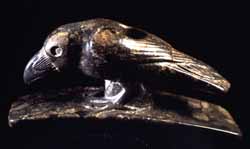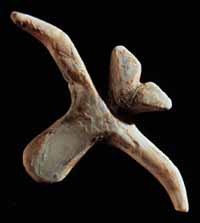
 |
Raven-effigy platform pipe, Rutherford site, Hardin County. | |
|
In addition to frogs and otters, birds often adorned smoking pipes. In this example, the detailed image of a raven is perched on the back of the pipe. |
||
Pipe smoking began late in the Archaic period and grew in significance during the Woodland period. Historically, Native Americans smoked tobacco and other dried plants in rituals of peace and war, to make offerings, treat disease, to purify, and to seal agreements. Such plants were also burned as incense, sprinkled, and buried with the dead. These traditions probably began centuries earlier.
Shamans (medicine men as they were called by French explorers) may have smoked tobacco and other plants to achieve trance-like states to communicate with the spirit world, possibly represented by the animal effigies that adorned their pipes.
During the Middle Woodland sub-period, elaborate burial offerings were placed with important people in burial mounds. These often included ornaments, pipes, tools, weapons of chipped stone, and specially made mortuary vessels.
 |
Freshwater mussel shell falcon, M. Thompson site, Fulton County. |
Late Woodland objects are often not as spectacular as those found at Middle Woodland sites. But many interesting objects, such as this falcon effigy made of freshwater mussel shell, have been found at Late Woodland sites. Animals often appear to be a source of inspiration for making a particular object. This underscores the importance of nature to Native Americans.
|
|
Copyright © 2000 Illinois State Museum